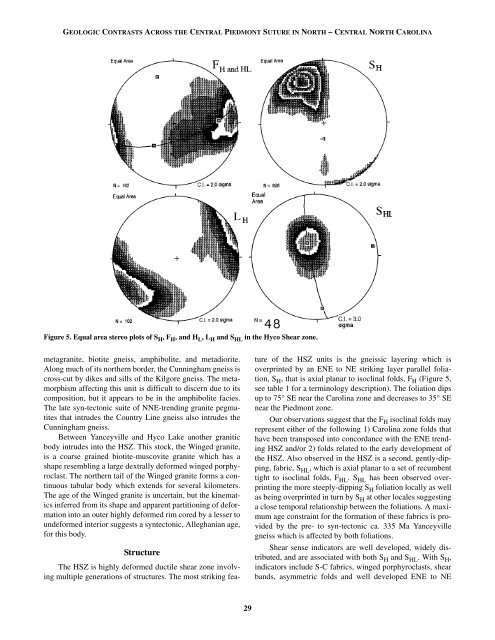Download Guidebook as .pdf (29.1 Mb) - Carolina Geological Society
Download Guidebook as .pdf (29.1 Mb) - Carolina Geological Society
Download Guidebook as .pdf (29.1 Mb) - Carolina Geological Society
Create successful ePaper yourself
Turn your PDF publications into a flip-book with our unique Google optimized e-Paper software.
GEOLOGIC CONTRASTS ACROSS THE CENTRAL PIEDMONT SUTURE IN NORTH – CENTRAL NORTH CAROLINA<br />
Figure 5. Equal area stereo plots of S H , F H , and H L , L H and S HL in the Hyco Shear zone.<br />
metagranite, biotite gneiss, amphibolite, and metadiorite.<br />
Along much of its northern border, the Cunningham gneiss is<br />
cross-cut by dikes and sills of the Kilgore gneiss. The metamorphism<br />
affecting this unit is difficult to discern due to its<br />
composition, but it appears to be in the amphibolite facies.<br />
The late syn-tectonic suite of NNE-trending granite pegmatites<br />
that intrudes the Country Line gneiss also intrudes the<br />
Cunningham gneiss.<br />
Between Yanceyville and Hyco Lake another granitic<br />
body intrudes into the HSZ. This stock, the Winged granite,<br />
is a coarse grained biotite-muscovite granite which h<strong>as</strong> a<br />
shape resembling a large dextrally deformed winged porphyrocl<strong>as</strong>t.<br />
The northern tail of the Winged granite forms a continuous<br />
tabular body which extends for several kilometers.<br />
The age of the Winged granite is uncertain, but the kinematics<br />
inferred from its shape and apparent partitioning of deformation<br />
into an outer highly deformed rim cored by a lesser to<br />
undeformed interior suggests a syntectonic, Alleghanian age,<br />
for this body.<br />
Structure<br />
The HSZ is highly deformed ductile shear zone involving<br />
multiple generations of structures. The most striking feature<br />
of the HSZ units is the gneissic layering which is<br />
overprinted by an ENE to NE striking layer parallel foliation,<br />
S H , that is axial planar to isoclinal folds, F H (Figure 5,<br />
see table 1 for a terminology description). The foliation dips<br />
up to 75° SE near the <strong>Carolina</strong> zone and decre<strong>as</strong>es to 35° SE<br />
near the Piedmont zone.<br />
Our observations suggest that the F H isoclinal folds may<br />
represent either of the following 1) <strong>Carolina</strong> zone folds that<br />
have been transposed into concordance with the ENE trending<br />
HSZ and/or 2) folds related to the early development of<br />
the HSZ. Also observed in the HSZ is a second, gently-dipping,<br />
fabric, S HL , which is axial planar to a set of recumbent<br />
tight to isoclinal folds, F HL . S HL h<strong>as</strong> been observed overprinting<br />
the more steeply-dipping S H foliation locally <strong>as</strong> well<br />
<strong>as</strong> being overprinted in turn by S H at other locales suggesting<br />
a close temporal relationship between the foliations. A maximum<br />
age constraint for the formation of these fabrics is provided<br />
by the pre- to syn-tectonic ca. 335 Ma Yanceyville<br />
gneiss which is affected by both foliations.<br />
Shear sense indicators are well developed, widely distributed,<br />
and are <strong>as</strong>sociated with both S H and S HL . With S H ,<br />
indicators include S-C fabrics, winged porphyrocl<strong>as</strong>ts, shear<br />
bands, <strong>as</strong>ymmetric folds and well developed ENE to NE<br />
29













